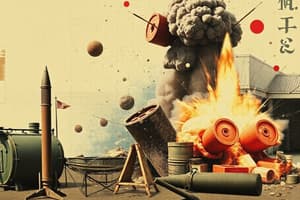Podcast
Questions and Answers
What is the primary focus of forensic ballistics?
What is the primary focus of forensic ballistics?
- Examining firearms usage in crimes and linking bullets to weapons (correct)
- Analyzing the environmental effects of gunpowder
- Studying the history of firearms development
- Understanding the chemical properties of propellants
What historical advancement in ballistics did Henry Goddard contribute to?
What historical advancement in ballistics did Henry Goddard contribute to?
- The concept of ballistic fingerprinting based on manufacturing defects (correct)
- The development of rifling in firearms
- The introduction of nitrocellulose as a propellant
- The use of magnification for ballistic evidence
How does cartridge case capacity affect combustion in internal ballistics?
How does cartridge case capacity affect combustion in internal ballistics?
- A larger empty space results in slower combustion (correct)
- A smaller volume leads to higher internal pressure
- Case capacity has no effect on combustion rates
- A larger volume allows for faster combustion
During the firing process, what happens immediately after the firing pin strikes the primer?
During the firing process, what happens immediately after the firing pin strikes the primer?
In what scenario is internal pressure at its highest during the firing process?
In what scenario is internal pressure at its highest during the firing process?
What was a significant limitation of black powder compared to modern nitro-based propellants?
What was a significant limitation of black powder compared to modern nitro-based propellants?
Which component is NOT traditionally associated with black powder?
Which component is NOT traditionally associated with black powder?
Which type of propellant is categorized as a double-based powder?
Which type of propellant is categorized as a double-based powder?
What was the main advancement introduced by Alfred Nobel in the field of propellants?
What was the main advancement introduced by Alfred Nobel in the field of propellants?
Which of the following is a purpose of additives in propellants?
Which of the following is a purpose of additives in propellants?
Flashcards are hidden until you start studying
Study Notes
A Brief History of Propellants
- Propellants combust quickly to produce gas, driving missiles down gun barrels.
- Common modern propellants are nitrocellulose-based powders; black powder is favored by muzzle-loading firearm enthusiasts.
Types of Propellants
- Black Powder: The earliest gunpowder consisting of potassium nitrate, sulfur, and charcoal; largely replaced by advanced propellants.
- Nitro Powders:
- Single-based: Made by dissolving nitrocellulose in ether and alcohol.
- Double-based: Formed by mixing nitrocellulose with nitroglycerine, with Cordite as a prominent example.
Black Powder Origins
- Early references date to Greek Fire (424 BC) and Chinese gunpowder (circa 1000 AD).
- Roger Bacon documented gunpowder in 1250; Berthold Schwartz popularized it in early 1300s Europe.
Nitro Powders Development
- Smokeless Powder: Invented by Vieille in 1884, using nitrocellulose for a stable propulsion method.
- Alfred Nobel enhanced smokeless powder by combining nitrocellulose with nitroglycerine, leading to double-based powders like Cordite for British military usage.
Additives in Propellants
- Additives improve performance and stability:
- Plasticizers (e.g., Triacetin) enhance flexibility.
- Stabilizers (e.g., Diphenylamine) prevent degradation.
- Gelatinizers (e.g., Dinitrotoluene) slow burning rates.
- Surface moderators (e.g., Graphite) control reaction speed.
Priming Compounds
- Priming compounds ignite propellant when struck, originally using unstable mercury fulminate.
- Current trends focus on lead-free, non-toxic primers to mitigate lead exposure.
Advantages of Nitro-Based Propellants Over Black Powder
- Require less material for the same effect.
- Customizable for various firearms and ammunition.
- Produce minimal residue and exhibit reduced corrosiveness.
Primers
- Evolution from hazardous materials to safer, lead-free alternatives is underway, aiming for non-toxic primers in shooting environments.
Glossary
- Black Powder: A mixture of potassium nitrate, sulfur, and charcoal.
- Gun Cotton: Nitrocellulose; essential in modern propellants.
- Lesmok: An old blend of black powder and gun cotton.
- Nitrocellulose: Nitrated cellulose, integral to contemporary propellant formulations.
Introduction to Forensic Ballistics and Internal Ballistics
- Ballistics examines projectiles, focusing on their behavior throughout launch, flight, and impact.
- Forensic Ballistics: Analyzes firearm-related crimes, relates bullets to weapons, and scrutinizes firearms and tool marks.
Objectives of Forensic Ballistics
- Grasp projectile behavior within firearms.
- Identify factors influencing projectile momentum during discharge.
History of Forensic Ballistics
- 1493-1508: Emperor Maximilian proposed rifling for accuracy; its forensic application developed later.
- 1835: Henry Goddard introduced ballistic fingerprinting.
- 1860: Regina v Richardson case established wadding as evidence.
- 1902: Oliver Wendell Holmes utilized magnification in firearms identification.
- 1912: Professor Balthazard employed photography for bullet marking comparisons.
- 1925: Calvin Goddard co-founded the Bureau of Forensic Ballistics in New York.
Internal Ballistics
- Studies internal gun processes from primer ignition to bullet exit.
- Firing Process: Primer ignition causes gas production that propels the bullet out.
- Cartridge Case Capacity: Empty space in cartridges affects propellant burn rates; larger space slows combustion.
- Internal Pressure: Peaks when the bullet is stationary, dropping as gas volume increases during movement.
Recoil and Velocity Calculations
- Recoil: The backward motion experienced during firing; example of a .45 caliber pistol at 14,000 lb per sq.in.
- Time in Barrel: Bullet travel time is brief, often as low as 0.001 seconds for pistols.
- Velocity Calculations: Velocity can be computed based on various internal ballistics parameters.
Studying That Suits You
Use AI to generate personalized quizzes and flashcards to suit your learning preferences.




